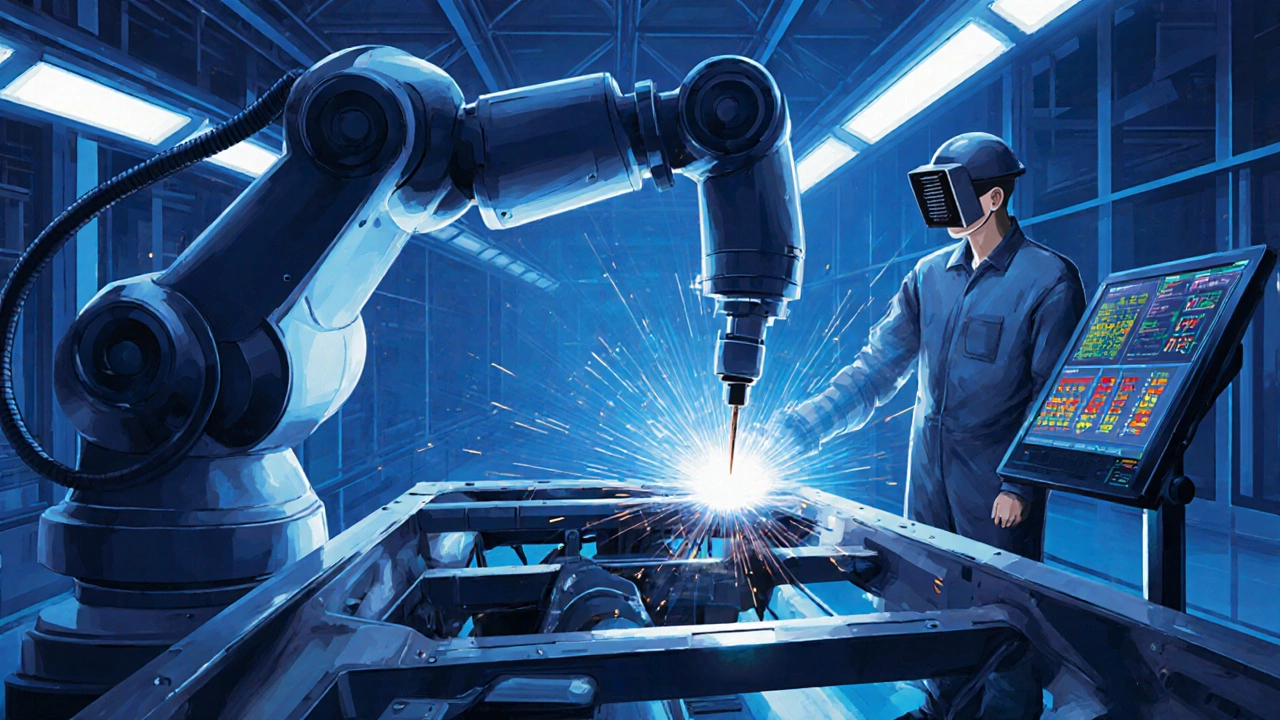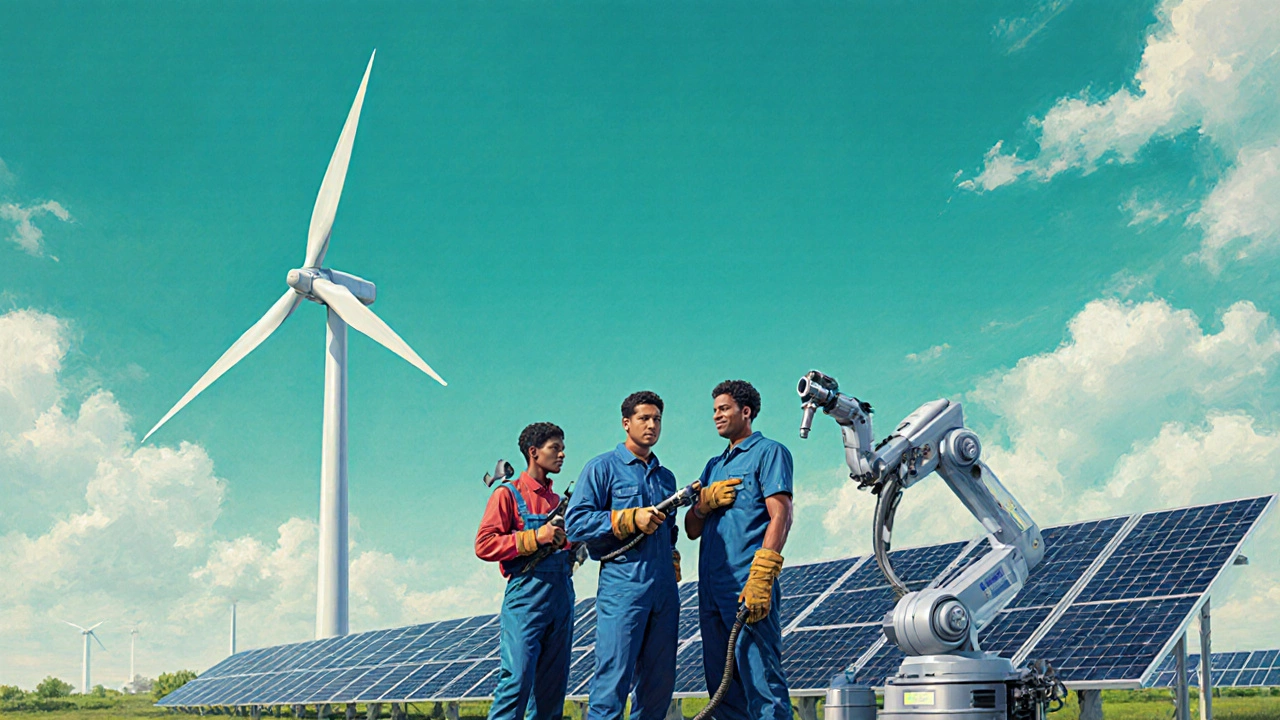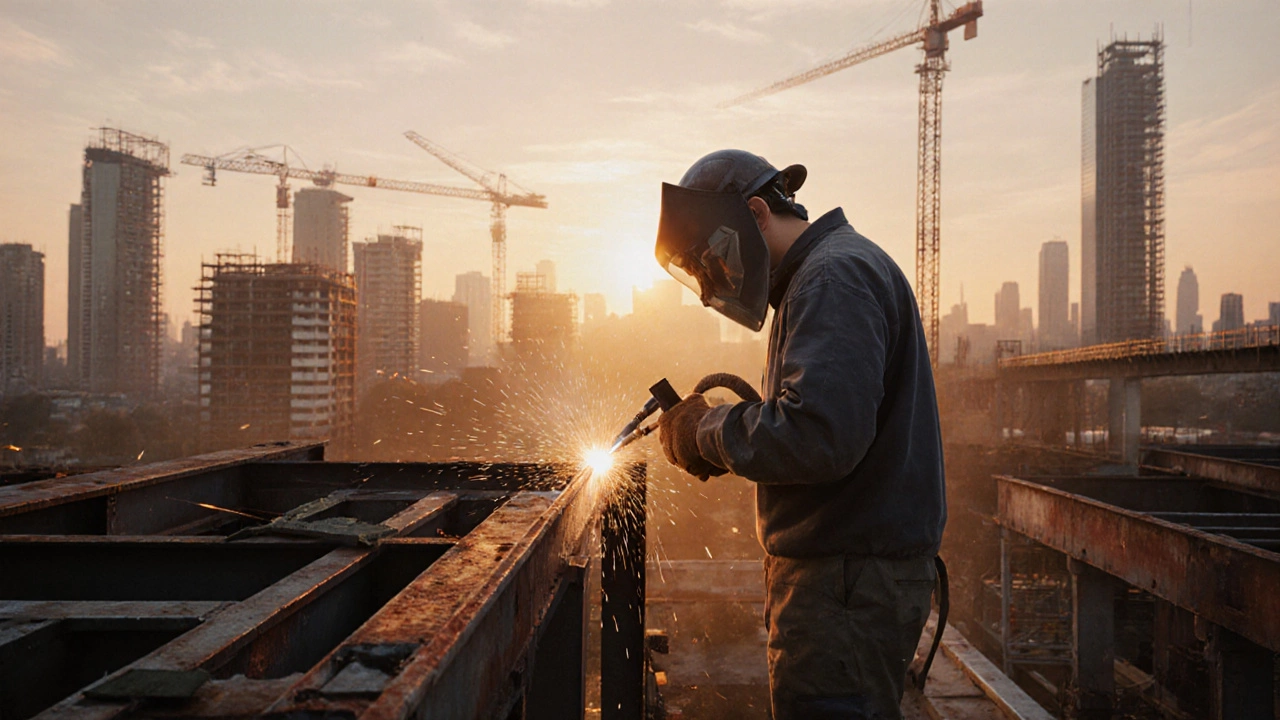Welding Sector Growth Outlook Calculator
This calculator estimates projected welding job growth in key sectors from 2025-2030 based on current data trends.
Select your preferred sector to see estimated job growth and key skills needed.
Projected Growth Details
Construction
+5.2% growth expected
SMAW, Structural-steel welding
Renewable Energy
+12.8% growth expected
TIG, Pipe welding
Manufacturing
+9.5% growth expected
Precision welding, CNC programming
Automotive (EV)
+7.4% growth expected
Spot welding, Battery-pack assembly
Oil & Gas (Pipe)
-3.1% decline expected
Pipe-welding, High-pressure standards
Key Takeaways
- The overall demand for welding job outlook remains steady, but growth varies by sector.
- Construction and renewable‑energy projects are the biggest drivers of new welding jobs in the UK.
- Automation is reshaping the trade - welders who learn robotics and advanced techniques stay in demand.
- Apprenticeships and certification programs are more critical than ever for entering the field.
- Regional nuances matter: some areas see declines while others experience a hiring surge.
What the Data Says About Welding Jobs Today
When we talk about Welding is a metal‑joining process that uses heat, pressure, or both to fuse parts together, the first question is whether fewer people are actually doing it. The answer isn’t a simple yes or no.
According to the UK Office for National Statistics (ONS) and the US Bureau of Labor Statistics (BLS), the total number of people employed as welders in 2024 hovered around 540,000 in the United States and roughly 28,000 in the United Kingdom. Those figures represent a modest rise of about 3‑4% from 2020, but the trend hides big differences between industries.
Historical Snapshot: 2010-2020
From 2010 to 2020 the welding trade saw two distinct phases. The early 2010s were marked by a post‑recession construction boom, lifting employment by an average of 1.8% per year. Around 2015, a slowdown in traditional building projects coincided with a surge in offshore wind and solar installations, shifting demand toward specialized pipe‑welding and structural‑steel roles.
By the end of the decade, the numbers looked like this:
- Construction‑related welding jobs grew 5% (2010‑2020).
- Manufacturing‑focused slots fell 2% as factories automated.
- Automotive‑industry welding saw a 4% dip, offset by a 9% rise in electric‑vehicle battery‑pack welding.
These shifts set the stage for the mixed picture we see in 2025.
Sector‑Level Drivers Shaping the Future
Today, four sectors dominate the demand for welders:
- Construction is a broad industry that builds residential, commercial, and infrastructure projects. New housing starts in England rose 6% in the past year, boosting need for structural‑steel welders.
- Manufacturing is a sector that produces goods ranging from consumer electronics to industrial machinery. While overall headcount fell, high‑precision welding for aerospace and medical devices grew 12%.
- Automotive industry is a global market that manufactures cars, trucks, and related components. The shift to electric vehicles (EVs) created a niche for battery‑module and chassis welding.
- Renewable energy is a fast‑growing field encompassing wind, solar, and green‑hydrogen projects. Offshore wind farms alone added 1,200 welding jobs in the UK between 2022‑2024.
Each sector also brings different skill requirements. A construction welder might specialize in SMAW (shielded metal arc welding), while a renewable‑energy technician often needs TIG (tungsten inert gas) and CNC‑controlled pipe welding.

Automation, Robotics, and the Changing Skill Set
The rise of Robotics is a technology that uses programmable machines to perform repetitive tasks has sparked a lot of headlines about jobs disappearing. In welding, the reality is more nuanced.
Automated welding cells are now common on high‑volume automotive lines, handling spot‑welding at speeds no human can match. However, these cells still need skilled technicians to set up parameters, troubleshoot defects, and perform maintenance - roles that command higher wages.
According to a 2023 study by the Institution of Mechanical Engineers, 38% of surveyed welders reported that they had received training in robotic programming, and 22% said they earned a promotion within a year of gaining that skill.
Bottom line: automation is not a death knell; it is a catalyst for up‑skilling.
Regional Nuances - Why Location Matters
In the UK, the North East and Scotland have seen a 7% increase in welding apprenticeships, driven by offshore wind projects and ship‑building contracts. Meanwhile, parts of the South East report a slight decline as construction firms outsource steel‑fabrication offshore.
Across the Atlantic, the US Midwest remains a stronghold for pipe‑welding in the oil‑and‑gas sector, though the sector is contracting by 3% annually. Conversely, the Pacific Northwest is booming with green‑hydrogen plant construction, demanding advanced welding certifications.
These regional patterns suggest that a blanket statement like “welding jobs are disappearing” ignores the granular reality.
Pathways to Future‑Proof Your Welding Career
If you’re considering a career in welding or wondering whether to stay, focus on three strategic moves:
- Enroll in an Apprenticeship is a structured training program that combines on‑the‑job learning with classroom instruction. The UK’s Advanced Craft Apprenticeship Standard (ACAS) for welding now includes a module on robotic welding.
- Earn industry‑recognized certifications such as the AWS (American Welding Society) Certified Welder, or the UK’s City & Guilds Level3 Diploma with a focus on TIG and MIG techniques.
- Invest time in digital skills - CNC programming, CAD reading, and basic PLC (programmable logic controller) knowledge are increasingly listed as “preferred” on job ads.
Employers also value soft skills: safety awareness, problem‑solving, and the ability to read complex schematics.
Comparing Sector Demand - A Quick Reference
| Sector | 2025 Jobs (UK) | Expected Growth % (2025‑2030) | Key Skills Needed |
|---|---|---|---|
| Construction | 9,500 | +5.2% | SMAW, Structural‑steel welding, Safety certification |
| Renewable Energy | 3,200 | +12.8% | TIG, Pipe welding, Offshore safety |
| Manufacturing (Aerospace/Medical) | 2,800 | +9.5% | Precision welding, CNC programming |
| Automotive (EV) | 1,900 | +7.4% | Spot welding, Battery‑pack assembly |
| Oil & Gas (Pipe) | 1,300 | ‑3.1% | Pipe‑ welding, High‑pressure standards |
The table makes it clear: sectors aligned with green infrastructure and high‑precision manufacturing are the growth engines, while traditional oil‑and‑gas pipe work is contracting.

Is Welding Right for You? Decision Checklist
- Do you enjoy hands‑on problem solving and working with metal? Welder is a skilled tradesperson who performs welding, cutting, and fabrication tasks is a physically active role.
- Are you willing to commit to continuous learning? Technological change means new certifications every few years.
- Do you prefer stable, location‑based work (construction) or project‑based travel (offshore wind)?
- Can you meet safety and health regulations consistently? A strong safety record improves employability.
If most answers are “yes,” welding still offers a solid career path, especially if you target the sectors highlighted above.
Where to Find Training and Current Job Openings
Here are some trusted resources for UK residents:
- City & Guilds - Offers Level2 and Level3 welding diplomas with a robotics module.
- National College for the Skilled Trades (NCST) - Provides apprenticeship placements with partner firms in renewable energy.
- Jobcentre Plus - Lists openings by region and sector; filter for “welder” and “apprenticeship.”
- Institute of Welding (IOW) - Publishes industry reports and hosts networking events.
Signing up for newsletters from these bodies keeps you ahead of hiring waves.
Bottom Line
Welding isn’t disappearing; it’s evolving. Demand stays strong in construction and renewable‑energy projects, while automation reshapes the skill set required. By focusing on modern certifications, robotics knowledge, and sector‑specific training, you can turn what looks like a “declining job” myth into a thriving, future‑proof career.
Frequently Asked Questions
Are welding jobs really declining in the UK?
Overall employment numbers for welders have held steady, but specific sectors like construction and renewable energy are actually growing. The decline is limited to traditional oil‑and‑gas pipe work and some low‑skill manufacturing roles.
How much can a welder earn after completing an apprenticeship?
In 2024 the median annual salary for a qualified welder in England was £31,500. Those who add robotic‑welding certification can see earnings rise to £38,000‑£45,000, especially in the offshore wind sector.
Do I need a university degree to become a welder?
No. Most employers accept Level2/3 diplomas or a recognized apprenticeship. Higher‑level technical courses are optional but can open doors to supervisory or engineering roles.
What is the biggest skill gap for welders today?
Proficiency with robotic and CNC‑controlled welding equipment. Employers are looking for candidates who can program, calibrate, and troubleshoot automated cells.
How can I stay updated on welding industry trends?
Subscribe to the Institute of Welding newsletter, follow trade magazines like "Welding Journal," and attend regional trade fairs such as the UK Manufacturing Expo.





Write a comment